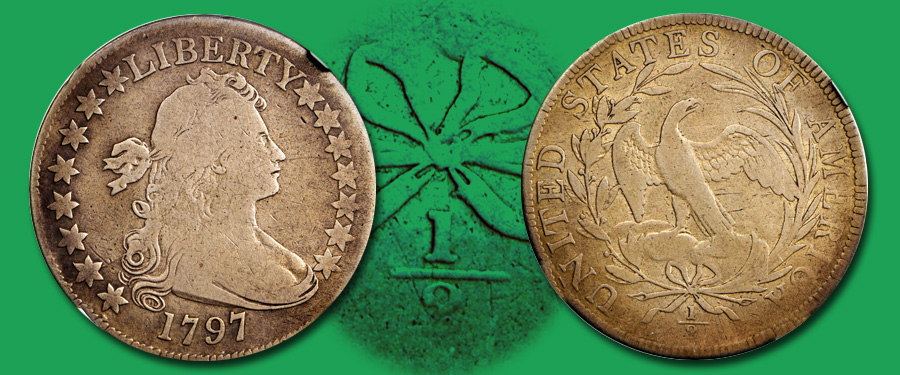
The
Stack’s Bowers Rarities Night session at our Official Auction of the ANA
World’s Fair of Money in August will include a gorgeous 1797 Draped Bust half
dollar. Delicate bronze iridescence overlays handsome slate gray surfaces that
remain smooth to the naked eye and free from noteworthy blemishes under a
glass. The motifs are bold and well defined for the type and the assigned
grade. The die crack at star 1 on the obverse that began in the Overton 101
pairing has progressed to Liberty’s hair curl, also joining together the
adjacent dentils below into one pyramidal mound. Slight softness is apparent at
the upper right on the obverse and at the corresponding lower right reverse,
though this is characteristic to the Overton 102 die pairing. The faintest mint luster is apparent around
the reverse devices.
The
1797 half-dollar is an enigmatic issue as well as a rare one. Echoing the
symbolism portrayed on the flag of the United States, the earliest coins of the
U.S. Mint depicted star counts intended to mirror the number of states in the
Union at the time of striking. The half dollars of 1794 and 1795 display 15
stars on the obverse reflecting Kentucky’s admission on June 1, 1792. In
anticipation of 1796’s half dollar mintage, officials prepared a 1796-dated
15-star die, though no half dollars were struck that year. By the time mintage
resumed in the beginning of 1797, Tennessee had joined the Union on June 1,
1796, and the 15-stars motif was inappropriate. Ever practical, the Mint
employed this incorrectly dated and starred obverse, eventually transitioning
to a 1796-dated 16-star obverse die. Then, most curiously, a third die was
created to finish out the 1797 half dollar production. It was properly dated
1797, though there were only 15 stars on the obverse. Several theories have
emerged to explain this regression, but the error in star-count for the 1797
Draped Bust half dollar has had numismatic scholars scratching their heads for
the past two centuries.
The
second anomaly of the 1797 Draped Bust half dollar can be observed on the reverse.
While a denomination represented by a fraction is familiar to early copper
enthusiasts, silver and gold coins bore no reference to their monetary worth
apart from an elusive mention on the coin’s third side — the edge. For the
precious metal issues of 1794 and 1795, size and weight were the primary
distinguishing characteristics between denominations. Researcher Steve Tompkins speculates that it
was the introduction of the quarter in 1796 that prompted the inclusion of the
fractional denomination on the reverse of the half dollars of the same vintage.
This idea is substantiated by the fact that once the initial fractioned-reverse
was retired, it was replaced by another reverse exhibiting a fraction,
dispelling the likelihood that the feature was added in error. That lone
replacement die was used to coin the balance of 1797-dated halves. Half dollar
production did not resume until 1801, and by then the Heraldic Eagle reverse
had done away with a stated denomination.
The noted
die marriages and somewhat ambiguous Mint records pertaining to the 1797 half
dollar will forever leave its true rarity in question. The example to be
offered in our August auction represents an exciting opportunity that will
surely be appreciated as this lot crosses the auction block!
This
important half dollar rarity will be offered alongside numerous other treasures
in the Rarities Night session of our August 2016 ANA World’s Fair of Money
Auction in Anaheim, California. To consign your rarities to this showcase
event, please contact our offices today at 1-800-458-4646 to speak with a
Consignment Director and see what Stack’s Bowers Galleries can do for you.





